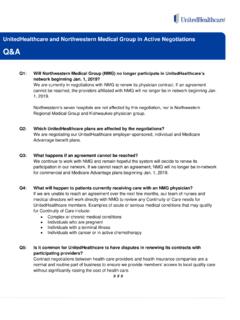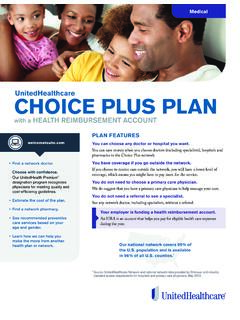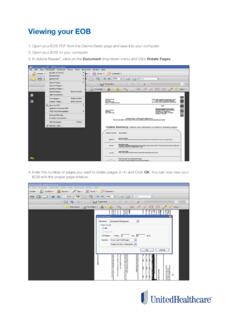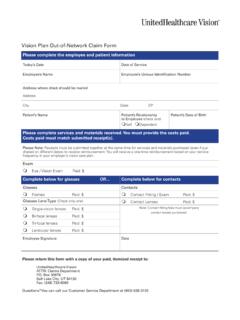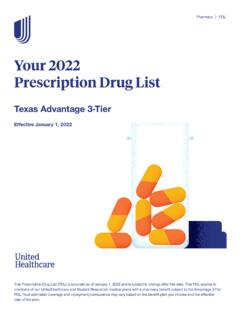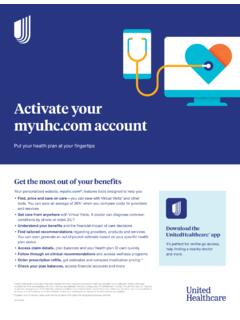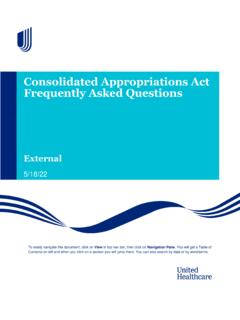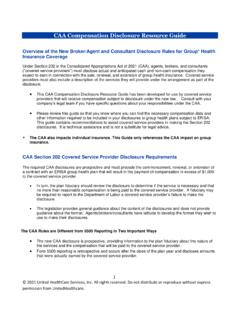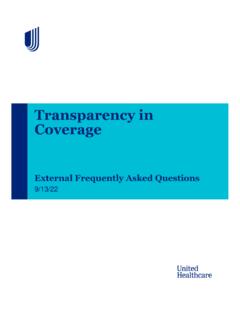Transcription of Your 2022 Prescription Drug List
1 Pharmacy | PDL. Your 2022. Prescription Drug List Traditional 3-Tier Effective January 1, 2022. This Prescription Drug List (PDL) is accurate as of January 1, 2022 and is subject to change after this date. This PDL applies to members of our UnitedHealthcare, River Valley, Oxford, and Student Resources medical plans with a pharmacy benefit subject to the Traditional 3-Tier PDL. Your estimated coverage and copayment/coinsurance may vary based on the benefit plan you choose and the effective date of the plan. Table of contents Understanding your Prescription Drug List (PDL).. 4. medication tips .. 5. Reading your PDL.. 6. Questions.. 7. Analgesics Drugs for Pain .. 8. Drugs for Pain and Inflammation.. 9. Anti-Addiction / Substance Abuse Treatment Agents.. 10. Antibacterials Drugs for Infections.. 10.
2 Anticoagulants Drugs to Treat or Prevent Blood Clots.. 11. Anticonvulsants Drugs for Seizures.. 11. Antidementia Agents Drugs for Alzheimer's Disease and Dementia .. 12. Antidepressants Drugs for Depression .. 12. Antiemetics Drugs for Nausea and Vomiting.. 13. Antifungals Drugs for Fungal Infections.. 13. Antigout Agents Drugs for Gout.. 13. Antimigraine Agents Drugs for Migraines.. 13. Antineoplastics Drugs for Cancer.. 14. Antiparasitics Drugs for Parasitic Infections.. 14. Anti-Parkinson's Agents Drugs for Parkinson's Disease.. 14. Antiplatelets Drugs for Heart Attack and Stroke Prevention.. 14. Antipsychotics Drugs for Mood Disorders .. 14. Antivirals Drugs for Viral Infections.. 15. Anxiolytics Drugs for Anxiety.. 16. Bipolar Agents Drugs for Mood Disorders .. 16. Cardiovascular Agents Drugs for Heart and Circulation Conditions.
3 16. Central Nervous System Agents Drugs for Attention Deficit Disorder.. 18. Drugs for Multiple Sclerosis.. 19. Miscellaneous .. 19. Dental and Oral Agents Drugs for Mouth and Throat Conditions.. 19. 2. Dermatological Agents Drugs for Skin Conditions.. 20. Diabetes Glucose Monitoring.. 22. Insulin.. 23. Non-Insulin Agents .. 24. Drugs for Blood Disorders.. 24. Drugs for Sexual Dysfunction.. 25. Electrolytes / Vitamins .. 25. Gastrointestinal Agents Drugs for Acid Reflux and Ulcer.. 25. Drugs for Bowel, Intestine and Stomach Conditions.. 26. Genetic or Enzyme Disorder Drugs for Replacement, Modification, Treatment .. 26. Genitourinary Agents Drugs for Bladder, Genital and Kidney Conditions.. 27. Drugs for Prostate Conditions .. 27. Hormonal Agents Hormone Replacement and Birth Control .. 27. Oral Steroids.
4 30. Other.. 30. Testosterone Replacement.. 31. Thyroid .. 31. Immunological Agents Drugs for Immune System Stimulation or Suppression.. 31. Infertility Agents.. 32. Inflammatory Bowel Disease Agents.. 32. Metabolic Bone Disease Agents Drugs for Osteoporosis.. 33. Ophthalmic Agents Drugs for Eye Allergy, Infection and Inflammation.. 33. Drugs for Glaucoma .. 33. Drugs for Miscellaneous Eye Conditions .. 34. Otic Agents Drugs for Ear Conditions.. 34. Respiratory Drugs for Anaphylaxis.. 34. Respiratory Tract / Pulmonary Agents Drugs for Allergies, Cough, Cold.. 34. Drugs for Asthma and COPD.. 35. Drugs for Cystic Fibrosis.. 36. Drugs for Pulmonary Hypertension.. 36. Skeletal Muscle Relaxants Drugs for Muscle Pain and Spasm.. 36. Sleep Disorder Agents.. 36. Index.. 37. 3. Understanding your Prescription Drug List (PDL).
5 What is a PDL? This document is a list of the most commonly prescribed medications. It includes About this PDL. both brand-name and generic Prescription medications approved by the Food and Where differences exist between Drug Administration (FDA). Medications are listed by common categories or classes this PDL and your benefit plan and placed in tiers that represent the cost you pay out-of-pocket. They are then documents, the benefit plan listed in alphabetical order. documents rule. This PDL is not a complete list of medications, How do I use my PDL? and not all medications listed You and your doctor can consult the PDL to help you select the most cost-effective may be covered by your plan. Prescription medications. This guide tells you if a medication is generic or a brand Please look at the benefit plan name, and if there are coverage requirements or limits.
6 Bring this list with you when documents provided by your you see your doctor. If your medication is not listed here, please visit your plan's employer or health plan to see member website or call the toll-free member phone number on your health plan which medications are covered ID card. under your plan. What are tiers? Tiers are the different cost levels you pay for a medication . Each tier is assigned a cost, set by your employer or benefit plan. This is how much you will pay when you fill a Prescription . See page 6 for more information. When does the PDL change? PDL changes typically occur 2-3 times per year. However, changes that have a positive impact for you such as coverage for new medications or cost savings may occur at any time. You can log in to the member website listed on your health plan ID.
7 Card at any time to check your medication coverage and lower-cost options. Why are some medications excluded from coverage? We review medications based on their total value, including effectiveness and safety, how much they cost, and the availability of alternative medications to treat the same or similar medical conditions. Certain medications may be excluded from coverage or be subject to prior authorization (sometimes referred to as precertification)1 if similar alternatives are available at a lower cost. Examples include medications that work the same way, but one is much more expensive than the other, or options that are available without a Prescription (also referred to as over-the- counter medications2). There are also some instances where the same product can be made by 2 or more manufacturers, but greatly vary in cost.
8 In these instances, only the lower-cost product may be covered. You should review your benefit plan documents to confirm if any medications are excluded from your plan. You can log in to the member website listed on your health plan ID card at any time to check your medication coverage. Talk to your doctor to see if there are lower-cost options or over-the- counter medications available. Who decides which medications are covered? Thousands of medications are already available and more come to the market regularly. Often, several medications are available to treat the same condition. The UnitedHealthcare Pharmacy and Therapeutics Committee, which includes both internal and external doctors and pharmacists, meets regularly to provide clinical reviews of all medications. Using this information, the PDL.
9 Management Committee, which includes senior UnitedHealth Group doctors and business leaders, meets to evaluate overall health care value. They also set coverage and tier status for all medications. 1. Depending on your benefit, you may have notification or medical necessity requirements for select medications. 2. For New York and New Jersey plans, a Prescription drug product that is therapeutically equal to an over-the- counter drug may be covered if it is determined to be medically necessary. 4. medication tips What is the difference between brand-name and generic medications? Over-the- counter Generic medications contain the same active ingredients (what makes the (OTC) medications medication work) as brand-name medications, but they often cost less. Once the An OTC medication may be patent for a brand-name medication ends, the FDA can approve a generic version the right treatment option for with the same active ingredients.
10 These types of medications are known as generic some conditions. Talk to your medications. Sometimes, the same company that makes a brand-name medication doctor about available OTC. also makes the generic version. options. Even though these medications may not be covered What if my doctor writes a brand-name Prescription ? by your pharmacy benefit, they may cost less than a If your doctor gives you a Prescription for a brand-name medication , ask if a generic Prescription medication . equivalent or lower-cost option is available and could be right for you. Generic medications are usually your lowest-cost option, but not always. For some benefit plans, if a brand-name drug is prescribed and a generic equal is available, your cost-share may be the copayment PLUS the cost difference between the brand- name drug and the generic equivalent.
